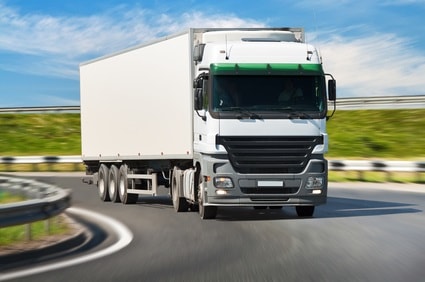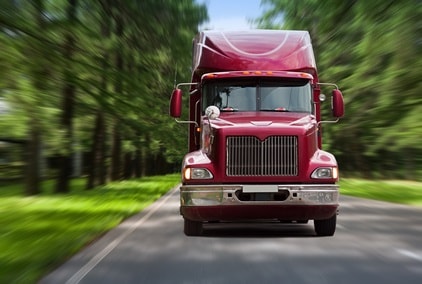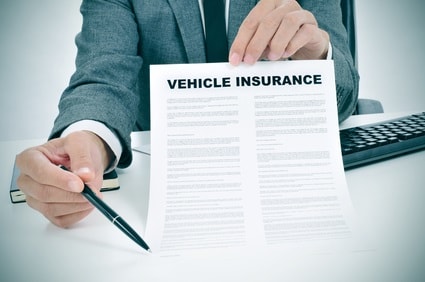Certain vehicles are required to have a USDOT Number, which serves as a unique identifier for the vehicle. These numbers are used for monitoring and collecting safety information for the purpose of audits and compliance reviews, inspections, and crash investigations. If your company engages in interstate commerce or certain types of intrastate commerce (such as transporting hazardous materials), obtaining a USDOT Number may be essential for compliance with state and federal regulations.
In this guide, we’ll cover everything you need to know about USDOT Numbers for commercial trucks, including requirements, uses, how to obtain a USDOT Number, and more.
Any company operating commercial vehicles that transport passengers or haul cargo in interstate commerce is required to have a USDOT Number and be registered with the FMCSA. In addition to these companies and vehicles, any commercial intrastate vehicles that transport hazardous materials — in any types or quantities that require a safety permit — must also register for a USDOT Number.

Specifically, a USDOT Number is required for vehicles used for intrastate commerce which:
Vehicles that are used for interstate commerce are required to have USDOT Numbers based on different requirements. Specifically, USDOT Numbers are required for vehicles used for interstate commerce which:
Interstate commerce is defined as any trade, traffic, or transportation in the United States occurring:
The responsibility for understanding and complying with the Federal Motor Carrier Safety Regulations falls on motor carrier operators and drivers, meaning that it’s up to commercial and passenger vehicle operators and their drivers to know whether regulations apply and take all necessary steps to ensure compliance.
In addition, 35 states, as well as Puerto Rico, require intrastate commercial vehicle registrants to obtain a USDOT Number, while the following 15 states do not:
The Federal Motor Carrier Safety Regulations (FMCSRs) exist to improve highway safety for passengers as well as other travelers that share the roads with vehicles hauling hazardous materials and engaging in interstate transport. These regulations include limits on the number of consecutive hours of service drivers may clock, which aim to prevent accidents resulting from fatigue. 
Property-carrying drivers may drive for a maximum of 11 hours following a minimum of 10 consecutive hours off duty, for instance, while passenger-carrying drivers are limited to 10 hours of driving following a minimum of eight consecutive hours off duty. Additionally, both passenger-carrying and property-carrying drivers may not drive after 60/70 hours on duty within a period of seven to eight days.
While compliance with many FMCSRs is the responsibility of the operator, the hours of service regulations, as well as some other requirements, rest on the shoulders of the drivers themselves. In fact, drivers are now required to maintain electronic logs documenting all hours of service, breaks, and other information to verify that these requirements are being met. A complete summary of the hours of service regulations can be found here.
Other regulations that fall under the FMCSRs applicable to drivers include (but aren’t limited to):
Requirements for companies include regulations surrounding periodic inspections, maintenance of commercial motor vehicles, and adequate insurance coverage, among other requirements designed to improve the safety of U.S. highways.
There are also some specific requirements pertaining to who is responsible for registering and displaying a USDOT number, particularly in the case of owner-operators. Historically, owner-operators leasing under a carrier’s authority simply used the carrier’s USDOT number and authority, although depending on the state, there are now some circumstances under which owner-operators must obtain their own USDOT Number and authority registration.
There are several steps involved in registering with FMCSA. First, determine if FMCSA registration is required (any operators or drivers meeting the applicability rules outlined above are required to register). This interactive questionnaire can help to determine if you’re required to obtain a USDOT number.
Then, you need to determine if you need an interstate Operating Authority number (known as an MC number). Companies required to obtain an MC number, in addition to a DOT number, include those which:
Operating authority under FMCSA is typically identified by the type of authority granted, including MC, FF, or MX numbers. In some cases, companies may be required to obtain multiple operating authorities, depending on what’s required to support the organization’s planned business operations. USDOT numbers, on the other hand, consist of a single application process for all operations.

The Operating Authority determines both the type of operation a company can run as well as the types of cargo a company is permitted to carry, as well as the insurance coverage requirements set forth by the FMCSA. The various types of authority include:
There are also additional types of authority used in special circumstances such as:

Some carriers are not required to have Operating Authority, including:
If a company determines that Operating Authority is required, the appropriate MC Number must be obtained and the appropriate proof of insurance coverage, if required, submitted to the FMCSA. For first-time registrants who do not already have a USDOT Number should register through the new Unified Registration System here. Those that are already registered and already have a USDOT Number, such as those applying for an additional authority, can apply online through FMCSA’s legacy registration system. Application status can be checked on the SAFER website.
After determining the need for obtaining Operating Authority and applying for an MC Number if required, companies should determine insurance requirements, obtain the appropriate coverage, and submit proof of coverage to FMCSA. Note that liability and cargo insurance forms must be submitted online by the insurance company furnishing the coverage. Coverage requirements include:
After handling proof of insurance requirements, companies must determine what state notification and registration requirements apply. FMCSA maintains a helpful resource with information on state governments, state consumer protection offices, and other entities that may have information on state-specific regulations.
Then, companies should begin the New Entrant Safety Assurance Program, which applies to both U.S. and Canada-based motor carriers. New entrants are monitored for a period of 18 months and are required to operate safely, maintain accurate and up-to-date records, perform regular maintenance and conduct periodic inspections on commercial motor vehicles, and pass a safety audit. During this initial 18-month period, FMCSA will monitor the company’s safety performance via roadside inspections, conduct safety audits on new entrants, and if deemed safe, grant permanent authority to the company.
Safety audits or reviews typically occur within 12 months of the start of operations, and compliance reviews or intervention may occur at any time FMCSA safety data indicates potential problems. New entrants will automatically fail the safety audit for any violations related to the following:
Note that some operators must also comply with other regulations, such as the Household Goods (HHG) Regulations and the Americans with Disabilities Act (ADA). While compliance with these regulations isn’t used as a determining factor in a safety audit, violations may result in investigation by other federal and state agencies as applicable.
To apply for a USDOT Number, there are several application options, depending on the type of operations the company engages in and other permits required:
Other forms and instructions, such as those for filing proof of insurance, applications for Operating Authority, and forms for Process Agents, can be found here.
Only after completing the New Entrant Safety Assurance program can companies apply for permanent USDOT registration. More information on this process can be found here. Even after permanent USDOT registration is obtained, it’s up to companies to maintain and update their USDOT Numbers and Operating Authority information as necessary. These updates may include routine updates, biennial updates, and inactivation, deactivation, and reactivation of USDOT Numbers.
It’s free to update information, but FMCSA does require that companies update their information at least every two years (biennial update). This requirement applies even to companies that have not changed any information as well as those that have discontinued interstate operations since the last update. Even companies that are no longer in business are required to complete a biennial update if they have not notified FMCSA of their business status. Companies that fail to complete a biennial update may have their USDOT Number deactivated and may be subject to civil penalties up to $1,000 per day, or a maximum of $10,000.
As USDOT Numbers are an important identification tool used to maintain records on commercial motor vehicles, there are specifications that dictate the size and appearance of the display of these numbers on vehicles. For commercial trucks, USDOT Numbers must be readily legible during the day from a minimum distance of 50 feet, with a minimum height of two inches. These numbers are most often displayed on the doors of the vehicle to meet the requirement that the number is displayed on the power unit, on both sides of the CMV.
USDOT Numbers must also be in a high contrast to the rest of the vehicle to ensure visibility. Additionally, CMVs must be marked with the legal name of the business entity controlling the motor carrier operation (or the “doing business as” or DBA name) – the business entity’s name as it appears on the MCS-150 form. As commercial motor vehicles regularly travel in hazardous weather conditions, companies should opt for highly durable data plates, such as Metalphoto® photosensitive anodized aluminum, for reliable transportation asset identification and regulatory compliance.
For more information on USDOT Numbers, FMCSA requirements, and the application process, visit the following resources:
Our sales engineers are experts in automatic asset tracking, tagging and identification,a nd can answer all your questions. Get in touch now.
Lets Talk ›